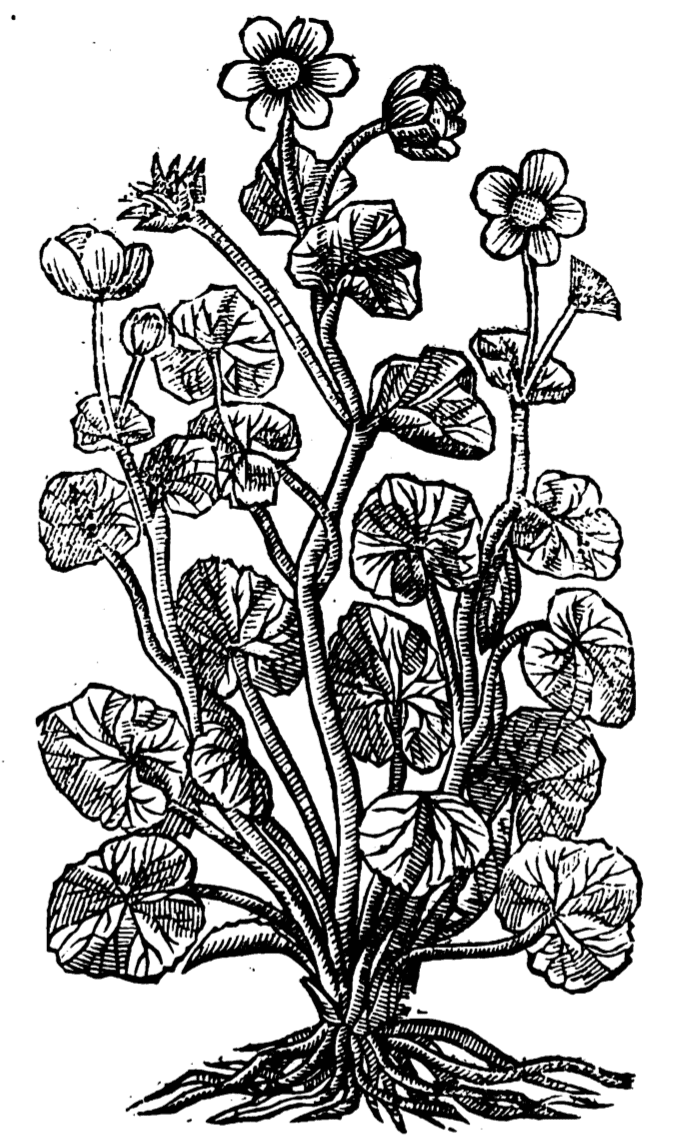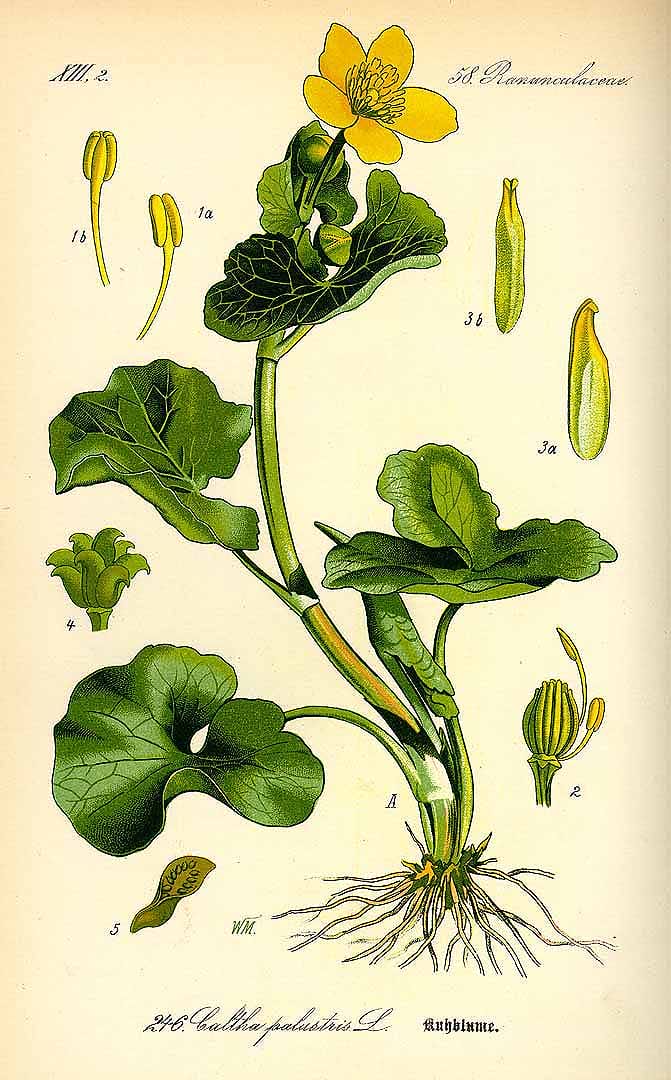Caltha, Marsh Marigold, Rta rmig རྟ་རྨིག་Marsh Marigold, Water Buttercup, Brave Celandine, American Cowslips, Tussilago alteraRta rmig (Tibet) Ma Ti Ye (TCM) Kushrya (Ayurveda) |

|
 Lesser Marsh Marigold
Lesser Marsh MarigoldSalmon, Botanologia (1710)
 Caltha palustris
Caltha palustris(Flora von Deutschland, Österreich und der Schweiz, Otto Wilhelm Thomé, 1885)
 Caltha palustris
Caltha palustris(Photo by Robert S Remie) (Wikimedia)
Botanical name:
Caltha spp.
- C. palustris (syn. C. polypetala) (West, Tibet, TCM)
- var. himalensis (Tibet)
- var. membranacea (TCM)
- var. sibirica (TCM)
- C. scaposa (Tibet)
- C. alba (Tibet)
Caltha palustris is found throughout the Northern Hemisphere in Europe, Asia and the U.S. Other local varieties such as the American C. flabellifolia (Mountain Marsh Marigold) are probably synonymous.
Parts used:
Aerial parts in flower
Temperature & Taste:
Very Warm, dry. Pungent, Sweet
Salmon said the root is Hot and dry.
Classification:
Uses:
1. Clears Wind, Resists Poison:
-Cold, Flu, acute Fever
-Summer-heat (TCM)
-Venomous Bites (Duke)
2. Moves the Blood, Disperses Swelling: (Tibet, TCM)
-Wounds, Trauma, Bruising
-acute inflammations
-Dysmenorrhea, Menstrual disorders (Herbal Medicine PDR)
-Scrofula, Tumors, Cancer (Duke)
-Uterine Cancer (Materia Medica And Therapeutics, Blair, 1907)
-heals Fractures (Tibet)
-‘constricts openings of the channels’ (Tibet)
3. Clears Damp, Promotes Urine:
-Edema, Fluid retention
-Jaundice
-it is also mildly laxative
4. Settles Wind:
-Convulsions (Infusion of the flowers)
-Anti-hypertensive
-CNS depressant
5. Benefits Blood:
-Tincture of the flowers has been used for anemia and pernicious anemia
6. Externally:
-Swellings
-Burns and Scalds (TCM)
-Boils, carbuncles (boil flowers and apply hot)
-Rashes, Sores, Herpes
-Warts
Dose:
The intense acridity of the fresh herb disappears totally after heating, such as boiling (Lloyd). Therefore, the brief decoction is probably the best preparation to use.
Tincture (1 in 10): 5 drops diluted
Generally only recommended for topical use in modern texts.
Substitute:
1. Generally similar to Crowfoot (Salmon)
2. Some have suggested it similar to Celandine. Marsh Marigold is covered under Celandine in some old Herbals such as A Niewe Herball (Dodoens, 1578)
Comment:
1. Despite being hot and potentially irritating, it has been used as a culinary spice: ‘The plant itself is used sauces and salad’ (Fuchs, 1549). It is evidently used like Rocket, but is hotter and therefore used in smaller amounts. The flower-buds are picked before opening and pickled where they are regarded as a good substitute for Capers.
2. ‘The Marsh Marigold is not used in Physick’. (A Niewe Herball, Dodoens, 1578)
3. ‘A tincture is made from the whole plant when in flower, and may be given with success for that form of bloodlessness with great impairment of the whole health, known as pernicious anemia’. (Herbal Simples, Fernie, 1897)
Main Combinations:
Major Formulas:
Cautions:
1. Avoid overdose. It is toxic in overdose and irritant to the mucosa, especially when fresh. However it contains lower levels of toxic protoanemonine-forming compounds compared to most other members of the Ranunculaceae. It contains benzylisoquinoline alkaloids and saponins.
Toxicity:
1. Overdose causes severe gastrointestinal irritation with gastralgia, colic, diarrhea. It can also irritate urinary passages.
Antidote:
1. Mucilage
2. Gastric lavage followed by activated charcoal.
